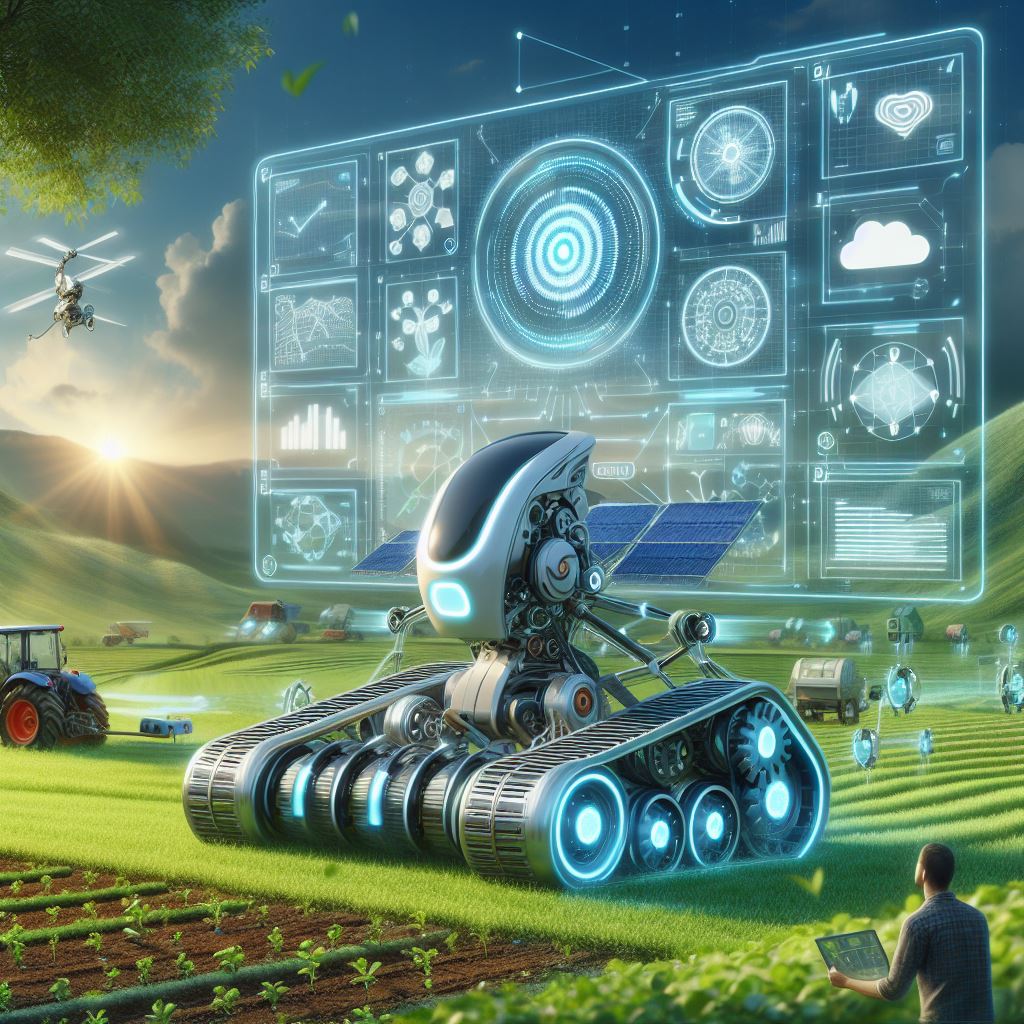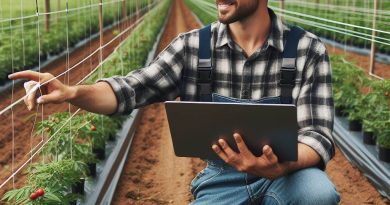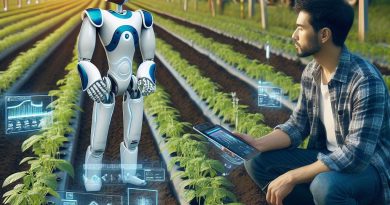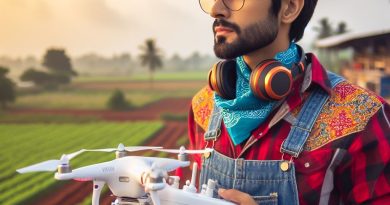Tech Trends: Agri Robotics in 2024
Last Updated on March 2, 2024
Introduction
Welcome to this blog post on Agri Robotics and its significance in the agricultural industry.
The use of robotics in agriculture has been on the rise in recent years, and it is expected to continue to grow in 2024.
The integration of technology in agriculture has led to increased efficiency, productivity, and profitability.
In this blog post, we will discuss the tech trends in Agri Robotics that are expected to shape the industry in 2024.
We will explore the latest advancements in robotics technology, including the use of drones, autonomous tractors, and robotic harvesters.
We will also examine how these technologies are being used to address some of the challenges facing the agricultural industry, such as labor shortages, climate change, and food security.
Our goal is to provide you with a comprehensive overview of the latest trends in Agri Robotics and how they are transforming the agricultural industry.
Whether you are a farmer, an agricultural researcher, or simply interested in the latest technological advancements, this blog post is for you.
So, let’s dive in and explore the exciting world of Agri Robotics!
Advancements in Agricultural Robotics
In 2024, the world of agriculture has witnessed significant advancements in the field of robotics.
These innovations have revolutionized farming practices and have proven to be highly beneficial for farmers.
Recent Advancements in Agri Robotics
- Autonomous Tractors: One of the major breakthroughs in agricultural robotics is the development of autonomous tractors. These vehicles can perform various farming tasks without human intervention.
- Robotic Weed Control: With the advancement of robotic technology, farmers can now effectively control weeds using specialized robots. These robots identify and eliminate weeds, reducing the need for manual labor and herbicides.
- Drone Usage in Agriculture: Drones equipped with advanced imaging technologies have become indispensable tools for farmers. They provide real-time data on crop health, soil conditions, and irrigation needs.
These advancements have transformed traditional farming practices and have offered numerous benefits to the agricultural sector.
Benefits of Using Robotics in Agriculture
- Increased Efficiency: Robotic systems can perform tasks more accurately and efficiently than manual labor. They ensure precision in seeding, planting, and harvesting, resulting in higher productivity.
- Reduced Labor Costs: Automation in agriculture reduces the dependency on human labor, resulting in reduced labor costs for farmers. The use of robots reduces the need for hiring and managing a large workforce.
- Improved Crop Yield: By utilizing robotics, farmers can monitor their crops more effectively. This allows for timely intervention in case of diseases or pests, leading to improved crop yield and quality.
- Optimized Resource Utilization: Agricultural robots enable farmers to optimize the utilization of resources such as water, fertilizers, and energy. They can precisely apply resources only where needed, minimizing waste and increasing sustainability.
- Enhanced Data Analytics: Robotics in agriculture generates vast amounts of data, which can be analyzed to make informed decisions. This data-driven approach helps in better crop management and planning for future seasons.
- Promotion of Sustainable Farming: Robotic systems support sustainable farming practices by minimizing the use of chemicals, reducing environmental impact, and conserving resources.
Generally, advancements in agricultural robotics have propelled the industry towards a more efficient and sustainable future.
Autonomous tractors, robotic weed control, and drone usage have transformed farming practices and offered several benefits.
The increased efficiency, reduced labor costs, improved crop yield, optimized resource utilization, enhanced data analytics, and sustainable farming practices are the key advantages of incorporating robotics in agriculture.
As we move forward, we can expect further innovations in this field, enhancing overall productivity and sustainability in the agricultural sector.
Read: Precision Agri: GPS Guided Farming Explained
Emerging Tech Trends in Agri Robotics
Tech trends that are expected to dominate the agri robotics industry in 2024
In the rapidly evolving field of agri robotics, there are several key tech trends that are anticipated to dominate the industry by 2024.
These trends have the potential to revolutionize the way farming and agriculture are conducted, enhancing productivity, efficiency, and sustainability.
The use of artificial intelligence (AI) and machine learning in agricultural robots to enable better decision-making
Artificial intelligence (AI) and machine learning technologies are playing a crucial role in the development and optimization of agricultural robots.
AI enables these robots to make real-time decisions based on gathered data, improving their adaptability and performance.
Machine learning algorithms allow them to learn from experience and continuously enhance their capabilities.
The integration of AI and machine learning in agricultural robots empowers them to perform a wide range of tasks, such as automated weeding, pest detection, crop monitoring, and precision spraying.
These technologies enable the robots to analyze vast amounts of data from sensors and cameras, enabling precise decision-making and targeted actions.
Integration of Internet of Things (IoT) technology in agri robotics for real-time data collection and analysis
Another significant trend in agri robotics is the integration of Internet of Things (IoT) technology.
IoT enables the robots to connect and communicate with various devices, sensors, and databases.
This seamless connectivity enables real-time data collection, analysis, and decision-making.
By employing IoT, agricultural robots can gather information on soil moisture, temperature, humidity, and other environmental parameters.
They can also collect data on crop health, growth patterns, and yield predictions.
This data is then processed and analyzed to provide farmers with valuable insights and actionable recommendations.
This integration of IoT technology allows farmers to monitor their fields remotely, reducing the need for manual labor and improving efficiency.
Farmers can access real-time data on their smartphones or computers and make data-driven decisions, optimizing resource allocation, and improving crop yield.
Essentially, the agri robotics industry is witnessing significant advancements and innovations, fueled by emerging tech trends.
The integration of AI and machine learning allows agricultural robots to make informed decisions and perform a range of tasks more efficiently.
The incorporation of IoT technology enables real-time data collection and analysis, empowering farmers with valuable insights.
As these tech trends continue to evolve, the future of agri robotics looks promising, with the potential to revolutionize the agriculture industry.
AI-powered Crop Monitoring Systems
The use of AI-powered crop monitoring systems to optimize irrigation and fertilizer application
Use of AI-powered crop monitoring systems revolutionizes the way irrigation and fertilizer application are optimized.
These advanced systems have the capability to analyze sensor data, enabling farmers to adjust spraying and irrigation patterns accordingly.
By utilizing AI, crop monitoring systems can precisely identify the specific needs of plants and deliver the appropriate amount of water and nutrients.
This technology improves the accuracy and efficiency of irrigation, reducing water wastage and minimizing the environmental impact of agricultural practices.
How these systems can analyze sensor data and adjust the spraying or irrigation patterns accordingly
AI algorithms enable real-time analysis of data collected by sensors placed in the fields, providing farmers with actionable insights.
With the help of AI-powered crop monitoring systems, farmers can make data-driven decisions, leading to increased yields and improved crop health.
These systems can detect early signs of diseases, pest infestations, and nutrient deficiencies, allowing farmers to take timely remedial actions.
By identifying potential issues early on, farmers can prevent crop losses and reduce the need for excessive pesticide use.
AI algorithms can also analyze weather forecasts and historical data to predict optimal irrigation schedules, saving both water and energy.
The ability of these systems to continuously monitor crops throughout their growth cycle ensures that plants receive precisely what they require.
By avoiding over- or under-watering, farmers can significantly reduce water consumption, resulting in cost savings and environmental conservation.
Furthermore, AI-powered crop monitoring systems enable farmers to analyze historical data, identifying long-term trends and patterns.
This information can be valuable for optimizing future crop planning, improving resource allocation, and better predicting market demands.
Potential benefits of such systems
The use of AI in agriculture allows for more efficient and sustainable farming practices, contributing to food security and environmental sustainability.
Farmers can receive automated notifications and alerts when deviations from ideal crop conditions occur, ensuring timely interventions.
These systems can also incorporate satellite imagery and remote sensing data, providing a comprehensive view of the entire agricultural landscape.
With AI-powered crop monitoring systems, farmers can make informed decisions about pest control and allocate resources more effectively.
Your plants are always under the watchful eye of these AI-powered systems, continuously analyzing data to ensure optimal growth conditions.
The integration of AI and robotics into agriculture has the potential to revolutionize the industry, making it more efficient and sustainable.
In general, AI-powered crop monitoring systems offer tremendous benefits, optimizing irrigation and fertilization, reducing wastage, and enhancing crop health.
Read: Robotic Hands in Fields: Future of Harvesting
Robotic Harvesting Systems
Advancements in Robotic Harvesting Systems
Robotic harvesting systems have seen significant advancements, especially for fruits and vegetables.
These robots are equipped with advanced sensors and algorithms to identify and pick ripe fruits without causing any damage.
The use of artificial intelligence allows these robots to learn and adapt to different types of fruits and vegetables.
The robots have precise grasping mechanisms that ensure gentle handling of the harvested produce.
Identifying and Picking Ripe Fruits
Through computer vision and machine learning, these robots can accurately identify ripe fruits based on color, size, and texture.
Advanced sensors help the robots detect the level of ripeness by measuring sugar content and scent.
The robots use mechanical arms with soft grippers that mimic human fingers, enabling them to pick fruits without bruising or damaging them.
The ability to distinguish between ripe and unripe fruits ensures high-quality produce and reduces waste.
Efficiency and Lower Labor Costs
Robotic harvesting systems offer significant improvements in efficiency compared to manual labor.
These robots can work continuously without breaks, resulting in higher productivity and faster harvesting times.
The precise and gentle handling of fruits reduces post-harvest losses due to damage.
By replacing human labor, robotic harvesting systems can significantly lower labor costs for farmers.
The reduced reliance on manual labor also addresses labor shortages in the agriculture industry.
Farmers can invest in robotic systems and save on long-term labor expenses.
Challenges and Future Developments
Despite the advancements, robotic harvesting systems still face some challenges.
The cost of acquiring and maintaining the robots can be a barrier for small-scale farmers.
The adaptability of the robots to different crops and farming practices needs further refinement.
Future developments should focus on making the robots more affordable and accessible to all farmers.
Integration with other agricultural technologies, such as autonomous vehicles, can further enhance overall efficiency.
In essence, Robotic harvesting systems have the potential to revolutionize the agriculture industry by improving efficiency and reducing labor costs.
Advancements in sensors, artificial intelligence, and mechanical design enable these robots to identify and pick ripe fruits without damaging them.
Although challenges exist, further developments can make robotic harvesting systems more affordable and adaptable for farmers worldwide.
The future of agri-robotics in 2024 looks promising, with the potential to transform the way we harvest fruits and vegetables.
Read: Smart Farming: IoT’s Role in Agriculture Today

Learn More: Tech for Organic Farming in 2024
Autonomous Pest Control
Development of autonomous pest control robots that can identify and target specific pests
The agriculture industry is constantly evolving, and one of the most promising advancements in recent years is the development of autonomous pest control robots.
These robots have the potential to revolutionize how farmers deal with pests, bringing about both efficiency and environmental benefits.
The use of AI and image recognition technology to identify pests and apply appropriate control methods
The key to effective autonomous pest control lies in the use of artificial intelligence (AI) and image recognition technology.
These robots are equipped with advanced cameras and sensors that allow them to identify specific pests by analyzing their physical characteristics.
This means that instead of relying on broad pesticide spraying, farmers can now target only the pests that pose a threat to their crops.
Imagine a future where these robots are deployed in large numbers across agricultural fields.
As they roam, they scan the crops, analyzing every leaf and stem for signs of pest infestation.
Once a pest is detected, the robot uses its AI capabilities to determine the appropriate control method.
This could include anything from spraying targeted chemicals to releasing natural predators.
The use of AI and image recognition technology not only improves the accuracy of pest control, but it also reduces dependence on harmful pesticides.
Currently, farmers often resort to excessive pesticide usage as a preventive measure to tackle potential pest problems.
This approach not only harms the environment but also increases the possibility of pesticide resistance in pests.
The potential reduction in pesticide usage and environmental benefits of autonomous pest control
With autonomous pest control robots, farmers can significantly reduce pesticide usage.
By precisely targeting pests, they can limit the amount of chemicals released into the environment.
This not only benefits the ecosystem but also minimizes the risk of pesticide contamination in food supplies.
Real-time data on pest populations and their movements
Moreover, autonomous pest control robots provide farmers with real-time data on pest populations and their movements.
This data can be analyzed and used to make informed decisions regarding pest control strategies.
Farmers can identify trends, implement preventive measures, and adjust their practices accordingly, leading to better crop yields and overall farm management.
Potential cost savings for farmers
Another advantage of autonomous pest control is the potential cost savings for farmers.
Traditional pest control methods can be time-consuming and labor-intensive, requiring farmers to manually inspect their crops and apply pesticides.
With robots taking over these tasks, farmers can save both time and money.
They can allocate their resources more efficiently and focus on other important aspects of farming.
Robots operate 24/7 providing continuous surveillance and protection for crops.
In addition, autonomous pest control robots can operate 24/7, providing continuous surveillance and protection for crops.
This is particularly beneficial during critical stages of plant growth and when pests are most active.
The robots can work tirelessly, ensuring that crops are safeguarded at all times.
As we look toward the future, it is clear that autonomous pest control robots have immense potential.
The combination of AI, image recognition technology, and robotics is poised to bring about a significant shift in how we approach pest management in agriculture.
With reduced pesticide usage, improved accuracy, and cost savings, these robots offer a sustainable and efficient solution to pest control challenges.
In a nutshell, the development of autonomous pest control robots represents a major breakthrough in the agricultural industry.
Their ability to identify and target specific pests using AI and image recognition technology has the potential to reduce pesticide usage and bring about substantial environmental benefits.
These robots not only improve the efficiency of pest control but also provide farmers with valuable data for informed decision-making.
With their continuous surveillance and cost-saving capabilities, autonomous pest control robots are set to shape the future of agriculture in 2024 and beyond.
Read: Drone Tech in Agriculture: A Sky-High View
Conclusion
The advancements and emerging tech trends in agri robotics in 2024 are set to revolutionize the agricultural industry.
With the integration of robotics, farmers will have access to more efficient and sustainable methods of cultivation.
Robotics in agriculture will enable increased precision and accuracy in tasks such as planting, watering, and harvesting crops.
This technology will also contribute to the reduction of labor costs and minimize the need for human intervention.
Moreover, agri robotics will enhance productivity by optimizing resource allocation and streamlining operations.
The potential benefits of agri robotics are immense, from improved crop yields to reduced environmental impact.
Farmers will be able to monitor and manage their crops in real-time, making data-driven decisions for better outcomes.
Furthermore, the use of robots will ensure a consistent and high-quality supply of food, meeting the demands of a growing population.
In the near future, agri robotics is expected to drive significant advancements in sustainable agriculture, making farming more efficient and environmentally friendly.
Exciting times lie ahead as agri robotics continues to evolve and shape the future of agriculture.
With increased automation and smarter technologies, the agricultural industry has the potential for tremendous growth and progress.
The integration of agri robotics is set to revolutionize farming practices, making them more sustainable, precise, and productive.
We eagerly anticipate the positive impact agri robotics will have on both farmers and consumers alike.
By embracing the opportunities presented by agri robotics, the agricultural industry is poised for a brighter and greener future.


